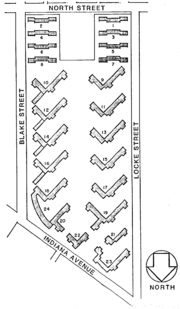
Lockefield Gardens
Encyclopedia
Lockefield Gardens was the first public housing
built in Indianapolis
. Built during the years of 1935 to 1938, it was built exclusively for low income blacks in Indianapolis. The complex was closed in 1976, and a number of structures were demolished in the early 1980s. Today, the only original structures remaining are those along Blake Street.
 Due to Franklin Delano Roosevelt's New Deal
Due to Franklin Delano Roosevelt's New Deal
, the Public Works Administration
started funding fifty low-cost public housing projects in twenty states from what were previously slum
areas. Indianapolis was chosen to have one of these renovations; it would be the first major public housing within Indiana's capital city. This land originally had 363 residences, of which only one was seen as "habitable". Another goal of the project was to provide temporary construction jobs in the area, 9,000 in total. This was done despite the wishes of Indiana congressmen, as they feared that private enterprises would be hurt by federal projects such as this.
 Three million dollars was spent on the Lockefield Gardens project, which opened in February 1938. Twenty-two acres along Indiana Avenue were chosen to become 748 separate housing units, under the direction of the Russ and Harrison architecture firm, built by N. P. Severin Company of Chicago, based on Europe
Three million dollars was spent on the Lockefield Gardens project, which opened in February 1938. Twenty-two acres along Indiana Avenue were chosen to become 748 separate housing units, under the direction of the Russ and Harrison architecture firm, built by N. P. Severin Company of Chicago, based on Europe
an prototypes. The twenty-four buildings which made up the complex ranged from two to four stories. "Corner", "strip", and "tee" models used by the Public Works Administration in other projects were used here. Among the amenities of this housing were a central mall, four playgrounds (with thirteen smaller play areas), a school (William D. McCoy Public School #24), and a small shopping arcade. It featured plenty of ventilation, abundant natural sunlight, and pleasant views of the area. Rents ranged from $20.80 to $30.10 a month. Lionel Artis was chosen as the original apartment housing manager, a position he held until his retirement in 1969, a span of over thirty years. After construction, it was considered one of the best of the New Deal housing projects. The spacial, wide-open areas of Lockefield Gardens were an oddity; other New Deal housing projects were cramped.
When it originally opened, Lockefield Gardens was racially segregated, but it allowed blacks something they rarely had: a community-oriented residence. Lockefield Gardens became the nucleus of black community located immediately northwest of downtown Indianapolis. In the 1950s, the guilt of some whites on a national level led to many blacks moving to what were residential areas mostly inhabited by whites. Due to income restrictions and more prosperous blacks leaving for the white residences, Lockefield Gardens began its decline. A redevelopment plan in the 1970s was hoped to revitalize the district, but federal judge S. Hugh Dillin thought it would lead to continued segregation of an educational and residential level. As a result, the apartments closed in 1976.
In 1980 it was decided that, in addition to an immediate need to house athletes from the Pan Am Games being hosted in Indianapolis, part of the Lockefield Gardens area would be used for the expansion of Indiana University-Purdue University Indianapolis
(IUPUI), a campus of both the Indiana University
and Purdue University
systems. In 1983, after demolitions, only units along Blake Street and Locke Street (now University Boulevard), out of the original twenty-four buildings, remained, despite protests by Indianapolis preservationists. Even still, the remaining structures were placed on the National Register of Historic Places
. Eleven new buildings were made, and the original buildings were renovated. The new total housing units of the complex was 493, with 199 of this total being within the original structures.
Public housing
Public housing is a form of housing tenure in which the property is owned by a government authority, which may be central or local. Social housing is an umbrella term referring to rental housing which may be owned and managed by the state, by non-profit organizations, or by a combination of the...
built in Indianapolis
Indianapolis
Indianapolis is the capital of the U.S. state of Indiana, and the county seat of Marion County, Indiana. As of the 2010 United States Census, the city's population is 839,489. It is by far Indiana's largest city and, as of the 2010 U.S...
. Built during the years of 1935 to 1938, it was built exclusively for low income blacks in Indianapolis. The complex was closed in 1976, and a number of structures were demolished in the early 1980s. Today, the only original structures remaining are those along Blake Street.
History

New Deal
The New Deal was a series of economic programs implemented in the United States between 1933 and 1936. They were passed by the U.S. Congress during the first term of President Franklin D. Roosevelt. The programs were Roosevelt's responses to the Great Depression, and focused on what historians call...
, the Public Works Administration
Public Works Administration
The Public Works Administration , part of the New Deal of 1933, was a large-scale public works construction agency in the United States headed by Secretary of the Interior Harold L. Ickes. It was created by the National Industrial Recovery Act in June 1933 in response to the Great Depression...
started funding fifty low-cost public housing projects in twenty states from what were previously slum
Slum
A slum, as defined by United Nations agency UN-HABITAT, is a run-down area of a city characterized by substandard housing and squalor and lacking in tenure security. According to the United Nations, the percentage of urban dwellers living in slums decreased from 47 percent to 37 percent in the...
areas. Indianapolis was chosen to have one of these renovations; it would be the first major public housing within Indiana's capital city. This land originally had 363 residences, of which only one was seen as "habitable". Another goal of the project was to provide temporary construction jobs in the area, 9,000 in total. This was done despite the wishes of Indiana congressmen, as they feared that private enterprises would be hurt by federal projects such as this.

Europe
Europe is, by convention, one of the world's seven continents. Comprising the westernmost peninsula of Eurasia, Europe is generally 'divided' from Asia to its east by the watershed divides of the Ural and Caucasus Mountains, the Ural River, the Caspian and Black Seas, and the waterways connecting...
an prototypes. The twenty-four buildings which made up the complex ranged from two to four stories. "Corner", "strip", and "tee" models used by the Public Works Administration in other projects were used here. Among the amenities of this housing were a central mall, four playgrounds (with thirteen smaller play areas), a school (William D. McCoy Public School #24), and a small shopping arcade. It featured plenty of ventilation, abundant natural sunlight, and pleasant views of the area. Rents ranged from $20.80 to $30.10 a month. Lionel Artis was chosen as the original apartment housing manager, a position he held until his retirement in 1969, a span of over thirty years. After construction, it was considered one of the best of the New Deal housing projects. The spacial, wide-open areas of Lockefield Gardens were an oddity; other New Deal housing projects were cramped.
When it originally opened, Lockefield Gardens was racially segregated, but it allowed blacks something they rarely had: a community-oriented residence. Lockefield Gardens became the nucleus of black community located immediately northwest of downtown Indianapolis. In the 1950s, the guilt of some whites on a national level led to many blacks moving to what were residential areas mostly inhabited by whites. Due to income restrictions and more prosperous blacks leaving for the white residences, Lockefield Gardens began its decline. A redevelopment plan in the 1970s was hoped to revitalize the district, but federal judge S. Hugh Dillin thought it would lead to continued segregation of an educational and residential level. As a result, the apartments closed in 1976.
In 1980 it was decided that, in addition to an immediate need to house athletes from the Pan Am Games being hosted in Indianapolis, part of the Lockefield Gardens area would be used for the expansion of Indiana University-Purdue University Indianapolis
Indiana University-Purdue University Indianapolis
Indiana University – Purdue University Indianapolis is an urban campus of Indiana University and Purdue University in Indianapolis, Indiana, United States. Indiana University is the managing partner...
(IUPUI), a campus of both the Indiana University
Indiana University
Indiana University is a multi-campus public university system in the state of Indiana, United States. Indiana University has a combined student body of more than 100,000 students, including approximately 42,000 students enrolled at the Indiana University Bloomington campus and approximately 37,000...
and Purdue University
Purdue University
Purdue University, located in West Lafayette, Indiana, U.S., is the flagship university of the six-campus Purdue University system. Purdue was founded on May 6, 1869, as a land-grant university when the Indiana General Assembly, taking advantage of the Morrill Act, accepted a donation of land and...
systems. In 1983, after demolitions, only units along Blake Street and Locke Street (now University Boulevard), out of the original twenty-four buildings, remained, despite protests by Indianapolis preservationists. Even still, the remaining structures were placed on the National Register of Historic Places
National Register of Historic Places
The National Register of Historic Places is the United States government's official list of districts, sites, buildings, structures, and objects deemed worthy of preservation...
. Eleven new buildings were made, and the original buildings were renovated. The new total housing units of the complex was 493, with 199 of this total being within the original structures.

